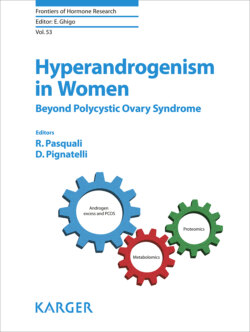Читать книгу Hyperandrogenism in Women - Группа авторов - Страница 32
Androgen Metabolism in Adipose Tissue
ОглавлениеIn adipose tissue, one of the main steroid-converting enzymes is aldo-keto reductase 1C (AKR1C) family which encompass 3 members (AKR1C1, AKR1C2, and AKR1C3) showing different substrate specificity. In men, AKR1C2 (3α-hydroxysteroid dehydrogenase), in particular, converted DHT into AD and, then, in ADG (inactivation androgens pathway) and its expression is increased in SAT when compared to VAT. Therefore, in the eugonadal male, the VAT adipogenesis is inhibited, given that DHT is poorly inactivated. Conversely, in obese men ARK1C2 expression is increased in VAT when compared to lean subjects and, moreover, visceral adipocytes are characterized by higher density of AR when compared to subcutaneous. Thus, hypogonadism, which occurs in men with severe obesity, facilitates fat deposition in VAT [15, 47]. On the other hand, in obese women as well as in those with PCOS, AKR1C3 converts A into T (activation androgens pathway) through its 17β-hydroxysteroid-dehydrogenase activity [48]. In vitro (adipose cellular supernatant) and in vivo (adipose tissue microdialysis) studies showed that AKR1C3 expression in the adipose tissue of PCOS is increased by insulin resistance [49].
Another key enzyme in androgen metabolism is 5α-reductase, in particular the type 1 isoform: it is expressed in different tissues, including the adipose one of both sexes, and converts T into DHT. Indeed, its inhibition by means of dutasteride (an inhibitor of both isoforms of 5α-reductase) facilitates fat deposition, in particular, in the liver of adult men, while its induction leads to hirsutism in obese women with PCOS [50–53].
A third class of enzymes is represented by UDP-glucuronosyl transferase (mainly UGT2B17 and UGT2B15) which is involved in the glucuronidation of 5α-end metabolites such as ADG and ADTG (inactivation androgens pathway). Since 5α-reductase activity is difficult to quantify in clinical practice, the glucoronate metabolites above quoted have been proposed as its indirect parameter. Indeed, both ADG and ADTG positively correlate with BMI in overweight adult men, whereas this correlation is negative in obese women without hirsutism and in severely obese hypogonadal men (BMI >40 kg/m2), indicating that 5α-reductase activity is very sensitive either to the circulating androgens or to those locally produced in the target tissues [20, 51, 54].
Adipose tissue is regarded as the major source of endogenous oestrogens after the gonads in both sexes, thanks to the aromatase activity, having C19 steroids as substrate [12, 55]. Given that its contribution increases with age and considering the expression of ER in adipose tissue, regional differences in aromatase expression (higher in SAT of thighs and buttocks than in VAT) have been associated with distribution of FM (i.e., gynoid fat distribution) [56, 57].
In conclusion, beside the thought of adipose tissue as a steroid reservoir, it should be considered an organ with intense enzyme activity by androgen synthesis, inactivation and conversion to oestrogens, co-regulating their metabolic clearance and production rates, eventually [58–60].
